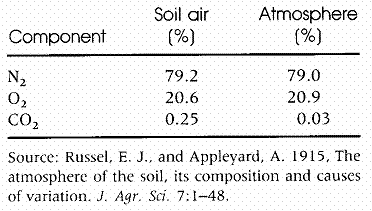
|
|||||
Soil AirIn nutrient management, soil aeration influences the availability of many nutrients. Particularly, soil air is needed by many of the microorganisms that release plant nutrients to the soil. An appropriate balance between soil air and soil water must be maintained since soil air is displaced by soil water. Air can fill soil pores as water drains or is removed from a soil pore by evaporation or root absorption. The network of pores within the soil aerates, or ventilates, the soil. This aeration network becomes blocked when water enters soil pores. Not only are both soil air and soil water very dynamic parts of soil, but both are often inversely related:
Soil air is very different than the above-ground atmosphere. A significant difference is between the levels of carbon dioxide. Since the soil contains high amounts of carbon dioxide, oxygen levels may become limited. Since plants must have oxygen to live, it is important to allow proper aeration in the soil. See Tables 3 and 4 for references to soil air composition. Table 3. Comparison between soil air and atmospheric composition Table 4. Soil Oxygen and Carbon Dioxide Content at Various Depths (Trinidad) Soil Atmosphere
|
|

